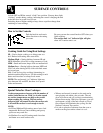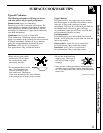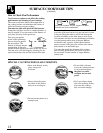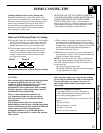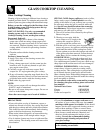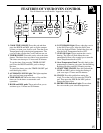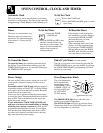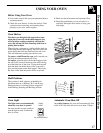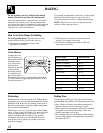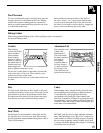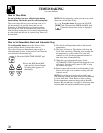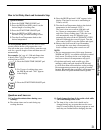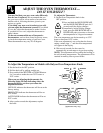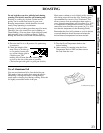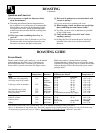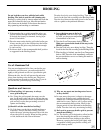
18
BAKING
Do not lock the oven door with the latch during
baking. The latch is used for self-cleaning only.
Your oven temperature is controlled very accurately
using an oven control system. We recommend that
you operate the range for a number of weeks using the
time given on recipes as a guide to become familiar
with your new oven’s performance.
If you think an adjustment is necessary, see the Adjust
the Oven Thermostat section. It gives easy Do It
Yourself instructions on how to adjust the thermostat.
NOTE: When the oven is hot, the top and outside
surfaces of the range get hot too.
How to Set Your Range for Baking
To avoid possible burns, place the shelves in the
correct position before you turn the oven on.
1. Turn the Oven Temperature knob to the
temperature you desire.
2. Check food for doneness at minimum time on
recipe. Cook longer if necessary.
3. Turn the Oven Temperature knob to OFF and
then remove the foods.
Oven Shelves
Arrange the oven
shelf or shelves in
the desired locations
while the oven is
cool. The correct
shelf position
depends on the kind
of food and the
browning desired.
As a general rule,
place most foods in
the middle of the oven, on either shelf position B or
C. See the chart for suggested shelf positions. B will
be used more than C.
Type of Food Shelf Position
Angel food cake A
Biscuits or muffins B or C
Cookies or cupcakes B or C
Brownies B or C
Layer cakes B or C
Bundt or pound cakes A or B
Pies or pie shells B or C
Frozen pies A (on cookie sheet)
Casseroles B or C
Roasting A or B
D
C
B
A
Preheating Baking Pans
Preheat the oven if the recipe calls for it. Preheat means
bringing the oven up to the specified temperature before
putting the food in the oven. To preheat, set the oven at
the correct temperature—selecting a higher temperature
does not shorten preheat time.
Preheating is necessary for good results when baking
cakes, cookies, pastry and breads. For most casseroles
and roasts, preheating is not necessary. For ovens
without a preheat indicator light or tone, preheat
10 minutes. After the oven is preheated, place the
food in the oven as quickly as possible to prevent
heat from escaping.
Use the proper baking pan. The type of finish on the
pan determines the amount of browning that will occur.
• Dark, rough or dull pans absorb heat resulting in a
browner, crisper crust. Use this type for pies.
• Shiny, bright and smooth pans reflect heat, resulting
in a lighter, more delicate browning. Cakes and
cookies require this type of pan.
• Glass baking dishes also absorb heat. When baking
in glass baking dishes, the temperature may need to
be reduced by 25°F.



